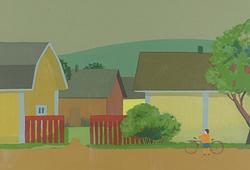Maurice Estève
"Le Guetteur"
Signed and dated bottom right Estéve 51 and signed verso Esteve / 51 / No 989. Canvas 50.5 x 61.5 cm.
Tuontiarvonlisävero
Tuontiarvonlisävero (12%) tullaan veloittamaan tämän esineen vasarahinnasta. Lisätietoja saat soittamalla Ruotsin asiakaspalvelumme numeroon +46 8-614 08 00.
Alkuperä - Provenienssi
Galerie Galanis, Paris.
Arild Wahlstrøm, Norweigan art collector, (1909 - 1994).
Einar Wahlstrøm, Oslo.
Thence by descent to the present owner.
Näyttelyt
Musée Cantonal des Beaux-Art, Lausanne, "Rythmes et couleurs", 1952.
Kirjallisuus
Robert Maillard & Monique Prudhomme-Estéve, "Maurice Esteve. Catalogue Raisonne De L'Oeuvre Peint. Idea et Calendes, no 370.
Muut tiedot
“I experience more intensely the nature in which I am immersed by the shapes I rediscover than the world in which I live” (quoted in R. Maillard, Maurice Estève. Polychrome, Ides et Calendes, 2001, p. 57).
Maurice Estève was born in the Culan area of France in 1904. In 1913 he moved with his parents to Paris, where he soon began his artistic career. Whilst visiting the Louvre in the 1920s he was particularly impressed by old masters such as Jean Fouquet and Paolo Uccello, but also by some of the pioneers of modernity, such as Paul Cèzanne, Fernand Legér and Georges Braque. Estève was mostly self-taught and only ever participated (in 1924) in the free teaching at the Acadèmie Colarossi.
Estève worked in a palette of warm and vibrating colours. From 1947 onwards he stopped depicting anything with a direct correlation to real forms or imagery. Instead his compositions merged into a pattern that had its own unique rhythm, clarity and purity. During the 1950s Estève stood out as a representative of the French branch of Tachisme (the name of the lyrical abstract spot painting that Georges Mathieu in particular employed). The style depicted colour and form in almost poetical expressions. With the painting in the auction, Le Guetteur [The Lookout] from 1951, Estève has just abandoned figurative painting, depicting real objects, and is instead painting without a premeditated subject in mind, filling the canvas with his own invented forms. Le Guetteur encompasses a wide variety of colours, each one more alive than the other – blue opaline, red, yellow, green and purple are set in contrast with the painting’s darker sections.






















































